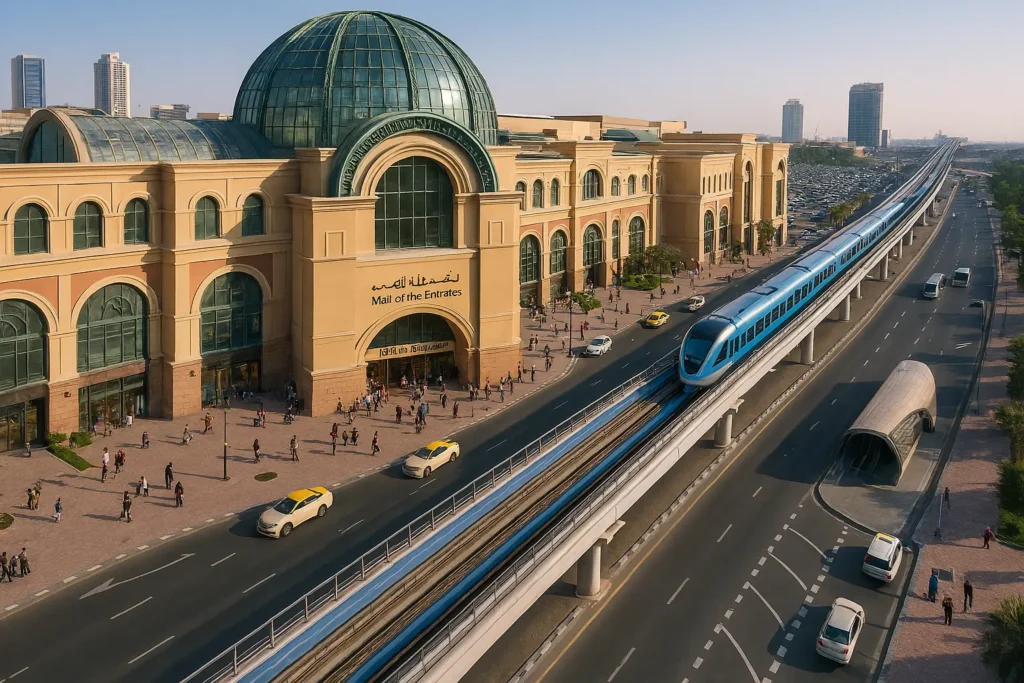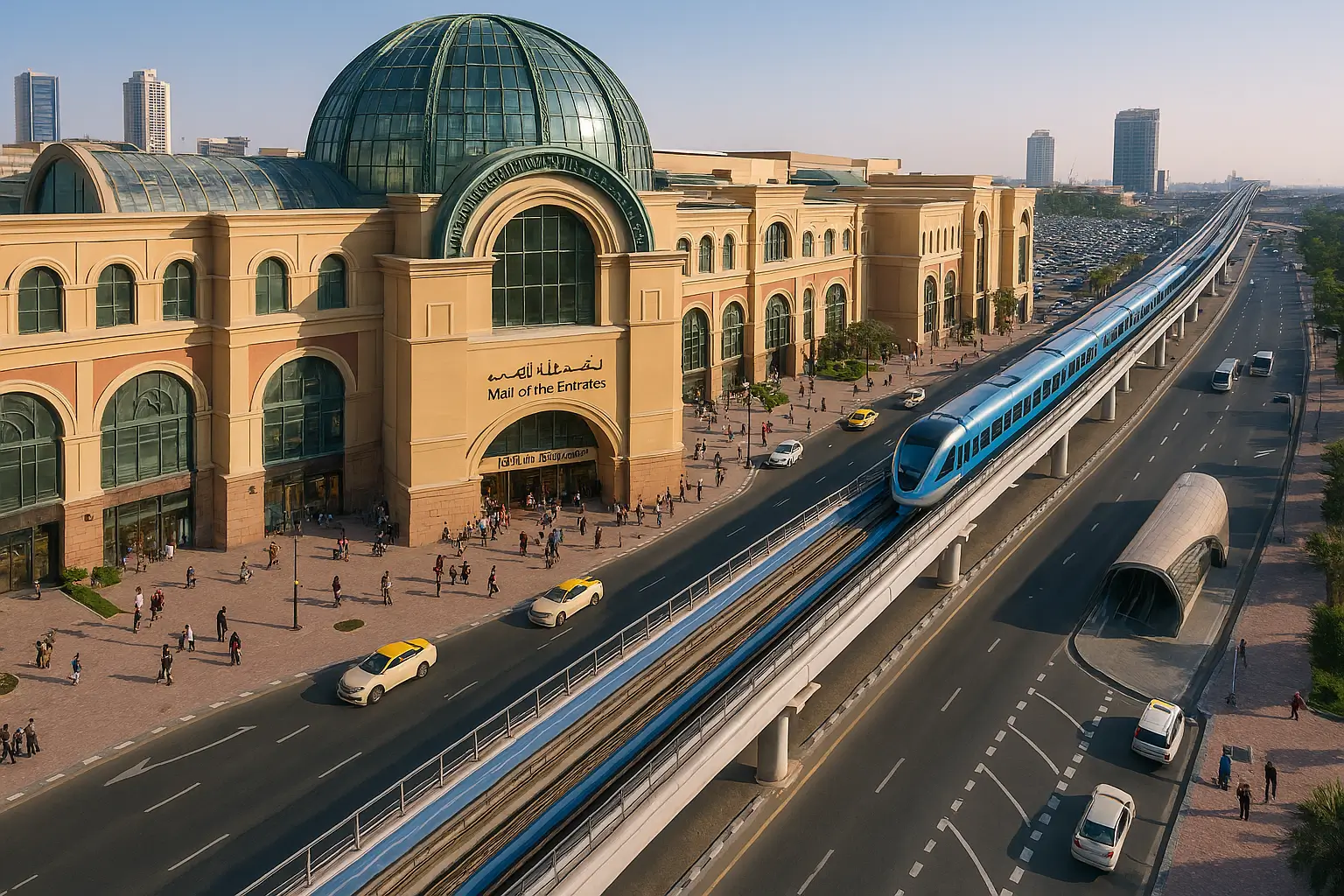Dubai’s Retail Boom: How Majid Al Futtaim’s Malls Thrive on Smart Transport Integration

In recent years, Dubai has set a new standard for what a shopping destination can be. Smart transport links and mega malls now go hand in hand, creating a powerful combination that attracts shoppers from around the globe. Majid Al Futtaim has led this change, shaping some of Dubai’s most iconic shopping spaces—think Mall of the Emirates and City Centre complexes.
Efficient metro lines, upgraded roadways, and futuristic projects have made it easier than ever for residents and tourists to reach sprawling retail centres in comfort. The link between these state-of-the-art malls and the city’s transport upgrades is clear: more accessible shopping draws bigger crowds and changes how people spend their time and money. Throughout this article, we’ll look at the impact of transport innovation on Dubai’s retail experience, and how business owners can take advantage of this shift.
For a closer look at how retail hubs continue to grow across the city, you might want to explore the Arabian Ranches souk: shopping and dining guide.
Curious about Dubai’s future in retail? This video breaks down what’s next for shopping and transport in the city: https://www.youtube.com/watch?v=GhwtVfU8gN0
Dubai’s Smart Transport Infrastructure
Dubai’s reputation for forward-thinking development is anchored by its transport systems. Whether you’re a business owner or a shopper, you’ll notice how much smoother the journey feels now. Take a look at any major mall on a weekend and you can see what happens when efficient metro lines and smart mobility projects power Dubai’s growth. Mall of the Emirates, City Centre Deira, and many others have become lively hubs—thanks to the city’s focus on making every step of the journey frictionless. Below, we break down how new transport upgrades work together to fuel retail’s success.
Metro Expansions and New Lines
Dubai’s Metro system keeps expanding, with new stations opening near top retail spots each year. The Red and Green Line extensions are prime examples. These upgrades efficiently link residential areas to business centres and shopping districts. For instance, the Red Line now stretches from Rashidiya all the way to the Expo 2020 site, allowing for fast access to renowned sites and malls.
What does this mean for shoppers and retail operators?
- Direct stops at major malls: New stations built close to entrances offer a near-doorstep connection for visitors.
- Wider reach: The Metro brings more neighbourhoods, business parks, and tourist hotspots into quick reach of retail.
- Surge in daily ridership: Each Metro expansion sparks a boost in daily users. Major mall stations can see thousands more commuters and shoppers, accelerating footfall.
With every kilometre added, these lines are stitched more tightly into the retail fabric of the city. You can explore the impact of future mega projects in The Future of Transportation in the UAE.
Autonomous and AI‑Powered Vehicles
Driverless shuttles and AI-powered taxis are no longer just a concept in Dubai. They’re visible at several transport hubs and mall entrances, streamlining first-mile and last-mile connectivity. Shoppers can leave the Metro and hop on a driverless shuttle, which whisks them to the nearest mall door.
Key features transforming retail access include:
- Driverless taxi trials: The Roads and Transport Authority (RTA) has begun driverless taxi trials, with wider rollout planned soon. These taxis use AI to predict demand and optimise routes—cutting waiting times for shoppers. More about these changes in Dubai to launch driverless taxi trials this year.
- Seamless shuttle service: Autonomous shuttles on mall premises mean visitors don’t need to worry about long walks from parking or metro.
- AI at the controls: The RTA’s Transport Command and Control Centre uses thousands of traffic sensors and AI to alleviate congestion and boost traffic throughput. This results in faster mall arrivals during peak hours, as shared by Smart Mobility in the UAE: Transport Tech.
Mall owners and businesses benefit as new technology makes shopping trips easier, encouraging frequent visits and longer dwell times. Retail is becoming smarter, one autonomous vehicle at a time.
Integrated Ticketing and RTA Initiatives
Dubai’s drive for convenience shows in its unified ticketing system. The Nol smart card and RTA mobile app remove many common barriers to city travel. Need to jump from the Metro to a bus and then on to mall parking? You just tap one card or app.
Main advantages shoppers now enjoy:
- One card for all journeys: Metro, bus, tram, and even water bus rides are possible with a single Nol card. Shoppers do not have to scramble for change or stand in line for tickets.
- Real-time app features: The official RTA app allows users to top up, plan routes, and even reserve parking at partner malls or transport hubs.
- Streamlined experience: These initiatives shorten waiting times and queue lengths, meaning visitors spend more time shopping and less time worrying about logistics.
The focus on digital integration supports Dubai’s wider vision for urban mobility, which can also be seen in general transport solutions like Al Dhafra International General Transport services.
Smart ticketing means every part of a trip, from stepping out the door to arriving at a mall, is now easier and more rewarding—for shoppers and retail businesses alike.
Mega Malls as Retail Hubs
Dubai’s mega malls do much more than house shops. They serve as neighbourhood landmarks, meeting points, and lifestyle centres. Their appeal reaches far beyond traditional retail. Easy public transport, family-friendly amenities, and ambitious redevelopment plans all add up, shaping an experience that draws residents and visitors again and again. Let’s see why these venues truly anchor Dubai’s retail scene.
Mall of the Emirates Transformation
Mall of the Emirates is raising the bar with a major upgrade planned for completion in 2025. The redevelopment includes an impressive 20,000 m² expansion, opening doors to new retail space and integrated experiences. This transformation introduces an innovative indoor-outdoor precinct, creating a seamless connection between shopping, open-air leisure, and community events.
This new precinct brings a fresh approach for busy shoppers and families by blending air-conditioned luxury with breezy relaxation. Brands will find state-of-the-art floorplans and technology. Visitors can expect shaded outdoor dining, live events, and lush green settings right next to favourite stores. It’s a bold step, building on Dubai’s drive to make retail not just convenient but inviting and memorable. For more on how Dubai’s retail sector is staying ahead with such investments, see Dubai’s Retail Sector Expands with New Investment Opportunities in 2025.
City Centre Network Reach
Majid Al Futtaim’s City Centre malls are designed to serve distinct communities, each with optimal access to transport. Positioning a mall near a Metro station or close to a major road isn’t an accident. It’s a deliberate strategy to connect people from all corners of Dubai, making every mall a hub for its neighbours.
Take a look at the reach:
- City Centre Deira: Situated near Deira City Centre Metro Station (Red Line), it’s a lifeline for those living around Al Rigga, Garhoud, and Port Saeed.
- City Centre Mirdif: Easy to reach via the Rashidiya Metro Station and the nearby Sheikh Mohammed Bin Zayed Road, serving Mirdif, Al Warqaa, and Mushrif.
- City Centre Al Shindagha: Linked well to the Green Line and busy road corridors, perfect for residents of Bur Dubai and Shindagha.
- City Centre Me’aisem: Placed strategically in Dubai Production City, with rapid access from the Sheikh Mohammed Bin Zayed Road, it covers communities like Jumeirah Village Circle, Sports City, and Motor City.
This hybrid of retail and transport means shoppers can take a quick ride, skip city traffic, and step right into their favourite mall. People are choosing these venues for day-to-day needs, relaxed weekends, or speedy errands. Direct Metro and road links transform shopping trips into a fast, reliable part of city life.
Leisure and Entertainment Mix
Mega malls in Dubai know shopping is just the beginning. The real draw is a world-class leisure mix that can fill a whole day, or even a weekend. These hubs keep visitors inside longer by using attractions that entertain, relax, and inspire.
Take a snapshot of what you’ll find:
- Cinemas: From multiplexes with luxury seats to immersive 4DX theatres, the latest blockbusters are always steps away from your shopping bags.
- Theme and Adventure Parks: Mall of the Emirates is home to the famous Ski Dubai, where families build snowmen year-round. City Centre Deira offers Magic Planet, a family entertainment centre blending arcade games and indoor thrills.
- Cultural Spaces: Many malls now host art showcases, live music, and local theatre. These events turn a routine visit into a memorable cultural experience.
- Wellness Centres: Health clubs, yoga studios, and world-class spas give shoppers a chance to recharge after a long shopping trip.
Adding these features is about more than just entertainment. Malls today are positioning themselves as lifestyle destinations, somewhere people can relax, celebrate, or even work remotely. Retailers benefit as dwell times increase and visitors are more likely to spend across multiple categories. For insight on how these trends are shaping future retail spaces, visit Future of Retail Real Estate in Dubai: Investment Trends 2025.
Dubai’s mega malls prove it’s possible to combine convenient access, world-class shopping, and community atmosphere under one roof. This powerful mix keeps them at the heart of modern city life.
Synergy Between Transport and Malls
Dubai’s story of retail strength has always been written hand in hand with transport upgrades. Metro stations beside mega malls are more than a convenience; they create foot traffic, support businesses, and shape shopper habits in ways that benefit the entire city. Let’s take a closer look at the numbers, real-world case studies, and the green shift that car-free access encourages.
Footfall boost from Metro stations: Present statistics showing percentage rise in visitors after Metro connectivity
The arrival of the Metro at Dubai’s shopping districts quickly changed the pattern of mall visits. Studies show that when a Metro station opens beside a major mall, footfall can increase by up to 30 to 40 percent within the first year. Take the Dubai Metro Red Line: shopper ridership spikes at retail-linked stops compared to those further from malls. Proximity enhances both the number of shoppers and how often they visit, benefiting both small kiosks and anchor stores.
For those interested in in-depth research, findings in the impact of transit-oriented shopping mall developments in Dubai document that shopper numbers are highest and spending per visit increases when Metro links are in place. Shoppers coming from further afield also stay longer, make bigger purchases, and enjoy more of the mall’s amenities.
Case study: Mall of the Emirates Metro link
Mall of the Emirates provides a textbook example of how thoughtful transport planning changes retail outcomes. When the dedicated Metro stop opened, weekend foot traffic went up, and the mall recorded a spike in international tourist visits and spending. The direct walkway from the Metro to the mall became a channel for tourists and city residents looking to save time and avoid traffic congestion.
International tourists, especially those arriving from Al Maktoum International Airport, started to factor Metro access into their Dubai itineraries. Many now plan their shopping and leisure days around malls connected to the Metro, which translates to longer visits and more retail spending. It’s not just about convenience; Metro linkage also broadens the catchment area, bringing in visitors who might otherwise have skipped a visit due to traffic or parking concerns.
See Dubai transport top stories August 19, 2025 for details on how these Metro-mall partnerships fit within the city’s current push for smart, connected mobility.
Sustainable, car-free shopping journeys
Dubai’s retail and transport collaboration is having another knock-on effect: it’s helping drive eco-friendly habits across a large section of the city. Choosing the Metro or bus over private cars means lower carbon emissions, less congestion in busy shopping areas, and a visible shift toward greener living. Mall developers now promote walkways and shaded connections from public transport, attracting residents who want to do their bit for the planet without sacrificing comfort.
Green-conscious shoppers are already embracing these changes. Metro-linked malls are reporting more footfall from residents who’d rather use public transport than drive. Parents are teaching their children the value of public transit, while tourists see car-free travel as part of the full Dubai experience.
By choosing the Metro, shoppers help keep pollution levels down and roadways less crowded, especially during peak retail seasons. Mall operators also benefit from reduced need for expensive parking expansions. As infrastructure continues to evolve, expect even more eco-initiative rollouts and awareness drives to encourage car-free journeys in and around Dubai’s biggest shopping attractions.
For more insight on sustainable urban shopping and how mall design supports car-free access, explore shopper passenger patterns on Dubai Metro Red Line. These studies reinforce the message: integrated transport makes both commercial and environmental sense.
Future Outlook and Opportunities
Dubai never stands still. The city is setting new ambitions for retail and transport, opening doors for business and shoppers alike. With technology-driven corridors like the Hyperloop on the horizon, mall developers and investors are preparing for the next leap. Majid Al Futtaim’s retail footprint is especially poised to grow as smart mobility shapes demand. The legacy of Expo 2020 continues to bring a steady flow of tourists seeking seamless, public transport-led experiences at mega malls. Let’s look at what’s ahead and why smart integration spells opportunity for everyone invested in Dubai’s retail scene.
Upcoming transport‑linked developments
 Photo by Ayrat
Photo by Ayrat
Dubai’s major upcoming leap is the planned Hyperloop, a high-speed corridor aiming to connect city suburbs with central business and shopping districts in minutes. This isn’t just an ambitious idea. It has been explored in depth by leading analysts, and could soon make cross-city travel as quick as boarding a metro. For those watching suburban mall traffic, this means:
- Easier access: A family in Dubailand or Silicon Oasis could zip to a mega mall on the outskirts or in the city centre without facing daily congestion.
- Broader catchment areas: Malls outside traditional zones stand to attract new shoppers from satellite communities, driving up weekday and evening visits.
- Lifestyle change: The Hyperloop could reshape the rhythm of retail entirely, making it as practical to visit a major mall after work as it is on a weekend.
Stay up to date on the vision behind Dubai’s mass transit projects in Dubai eyes Hyperloop-style system. For an even more sustainable twist, city leaders are also exploring concepts like THE LOOP—a climate-controlled cycling and pedestrian superhighway—which would encourage healthy, car-free trips to malls and leisure hubs. See more about this forward-looking proposal at THE LOOP – URB.
Investment prospects for Majid Al Futtaim
When you link a shopping powerhouse like Majid Al Futtaim’s mall network with future transport upgrades, the results speak for themselves. Integrated public transport directly lowers investment risk in retail real estate. Why? Because predictable, steady access means reliable footfall, and less dependence on shifting traffic patterns or parking limitations. Investors benefit from:
- Reduced vacancy risk: Malls with strong metro or Hyperloop links attract higher occupancy rates. Global brands and local players want in when the crowds are guaranteed.
- New revenue streams: Enhanced connectivity makes it practical to introduce new services, pop-up events, and late-night offerings that draw commuters and families throughout the week.
- Future-proofing: Ongoing investments in transport integration keep malls relevant, boosting asset value even in a fast-changing market.
A clear-eyed approach is key for retail investors. Those backing malls with built-in transit solutions will likely see stronger, resilient growth and healthier long-term returns. For a closer analysis of how retail hubs adapt in Dubai’s evolving urban landscape, visit Future of Retail Real Estate in Dubai: Investment Trends 2025.
Impact on tourism post‑Expo 2020
Expo 2020 gave Dubai’s infrastructure a major update—and the effects are still visible. Visitors flock to the city, many drawn by the promise of easy access to all the shopping, dining, and entertainment they crave. Malls that tie into metro or bus corridors, or bring new transport links on board, find themselves at the top of every tourist’s list.
The benefits of Expo’s legacy include:
- Well-connected routes: Direct metro lines to retail hubs created during Expo are still active, making journeys straightforward for tourists.
- Consistent visitor numbers: Tourists can plan their days around malls that promise short, predictable trips—no worries about taxi availability or city traffic.
- Repeat travel: Many visitors now build Dubai trips around public transport, choosing hotels near stations and picking malls they can reach with ease.
The result? Retailers see higher international spending, mall owners track longer visit durations, and Dubai’s tourism economy gets a steady boost. Malls fully integrated with public transport enjoy a genuine edge when global travel surges, proving once again that Dubai’s approach leads the region.
For another look at how malls shape Dubai’s community experience, explore the Arabian Ranches souk: shopping and dining guide. This topic shows that transport isn’t the only factor—community-driven design paired with easy access is what makes Dubai’s mega malls stand apart.
Conclusion
Dubai’s tight link between smart transport and mega malls has unlocked a shopping experience the city can claim as world-class. When you connect reliable metro access, autonomous vehicles, and a focus on convenience with carefully planned retail centres, the return is clear: more visitors, longer stays, and healthy business growth.
Majid Al Futtaim’s network stands out for putting transport integration at the core of its strategy. This forward-thinking approach gives every mall a clear edge, setting a new standard not just in the region but for cities everywhere aiming to boost retail through smarter infrastructure.
Business leaders can look to Dubai as proof that prioritising both movement and shopping together delivers long-term rewards. The city’s example offers a smart formula for anyone focused on future-ready, customer-driven urban growth.
Thank you for reading. Share your experiences or thoughts—how do transport upgrades change your own shopping habits? Let’s continue the conversation and keep building on what works.

